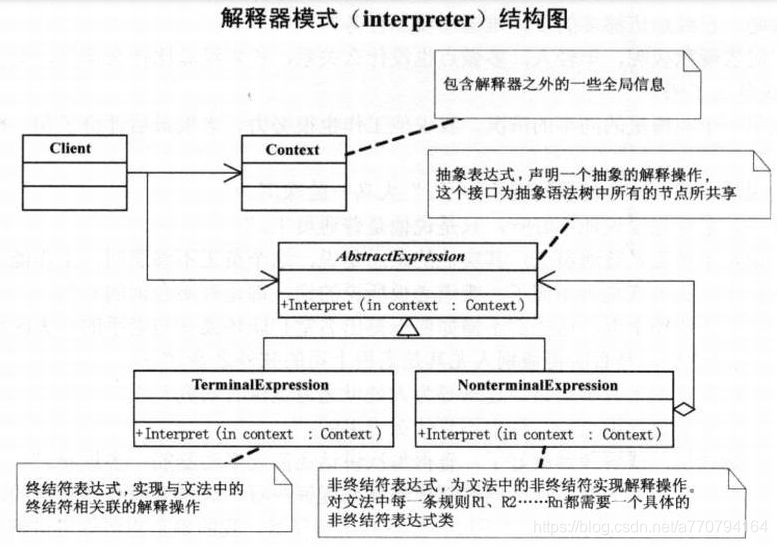版权声明:本文为博主原创文章,未经博主允许不得转载。 https://blog.csdn.net/a770794164/article/details/90744617
解释器模式(interpreter),给定一个语言,定义它的文法的一种表示,并定义一个解释器,这个解释器使用该表示来解释语言中的句子。

参考文章
JAVA设计模式(22):行为型-解释器模式(Interpreter)
参考文章中的例子:
例如机器人控制指令“down run 10 and left move 20”,可以采用解释器来实现对指令的解析。
- 抽象表达式AbstractNode
//抽象表达式
abstract class AbstractNode {
public abstract String interpret();
}
- 终结符表达式与非终结符表达式
//And解释:非终结符表达式
class AndNode extends AbstractNode {
private AbstractNode left; //And的左表达式
private AbstractNode right; //And的右表达式
public AndNode(AbstractNode left, AbstractNode right) {
this.left = left;
this.right = right;
}
//And表达式解释操作
public String interpret() {
return left.interpret() + "再" + right.interpret();
}
}
//简单句子解释:非终结符表达式
class SentenceNode extends AbstractNode {
private AbstractNode direction;
private AbstractNode action;
private AbstractNode distance;
public SentenceNode(AbstractNode direction,AbstractNode action,AbstractNode distance) {
this.direction = direction;
this.action = action;
this.distance = distance;
}
//简单句子的解释操作
public String interpret() {
return direction.interpret() + action.interpret() + distance.interpret();
}
}
//方向解释:终结符表达式
class DirectionNode extends AbstractNode {
private String direction;
public DirectionNode(String direction) {
this.direction = direction;
}
//方向表达式的解释操作
public String interpret() {
if (direction.equalsIgnoreCase("up")) {
return "向上";
}
else if (direction.equalsIgnoreCase("down")) {
return "向下";
}
else if (direction.equalsIgnoreCase("left")) {
return "向左";
}
else if (direction.equalsIgnoreCase("right")) {
return "向右";
}
else {
return "无效指令";
}
}
}
//动作解释:终结符表达式
class ActionNode extends AbstractNode {
private String action;
public ActionNode(String action) {
this.action = action;
}
//动作(移动方式)表达式的解释操作
public String interpret() {
if (action.equalsIgnoreCase("move")) {
return "移动";
}
else if (action.equalsIgnoreCase("run")) {
return "快速移动";
}
else {
return "无效指令";
}
}
}
//距离解释:终结符表达式
class DistanceNode extends AbstractNode {
private String distance;
public DistanceNode(String distance) {
this.distance = distance;
}
//距离表达式的解释操作
public String interpret() {
return this.distance;
}
}
- 指令处理类
class InstructionHandler {
private String instruction;
private AbstractNode node;
public void handle(String instruction) {
AbstractNode left = null, right = null;
AbstractNode direction = null, action = null, distance = null;
Stack stack = new Stack(); //声明一个栈对象用于存储抽象语法树
String[] words = instruction.split(" "); //以空格分隔指令字符串
for (int i = 0; i < words.length; i++) {
//本实例采用栈的方式来处理指令,如果遇到“and”,则将其后的三个单词作为三个终结符表达式连成一个简单句子SentenceNode作为“and”的右表达式,而将从栈顶弹出的表达式作为“and”的左表达式,最后将新的“and”表达式压入栈中。 if (words[i].equalsIgnoreCase("and")) {
left = (AbstractNode)stack.pop(); //弹出栈顶表达式作为左表达式
String word1= words[++i];
direction = new DirectionNode(word1);
String word2 = words[++i];
action = new ActionNode(word2);
String word3 = words[++i];
distance = new DistanceNode(word3);
right = new SentenceNode(direction,action,distance); //右表达式
stack.push(new AndNode(left,right)); //将新表达式压入栈中
}
//如果是从头开始进行解释,则将前三个单词组成一个简单句子SentenceNode并将该句子压入栈中
else {
String word1 = words[i];
direction = new DirectionNode(word1);
String word2 = words[++i];
action = new ActionNode(word2);
String word3 = words[++i];
distance = new DistanceNode(word3);
left = new SentenceNode(direction,action,distance);
stack.push(left); //将新表达式压入栈中
}
}
this.node = (AbstractNode)stack.pop(); //将全部表达式从栈中弹出
}
public String output() {
String result = node.interpret(); //解释表达式
return result;
}
}
- 主程序
class Client {
public static void main(String args[]) {
String instruction = "up move 5 and down run 10 and left move 5";
InstructionHandler handler = new InstructionHandler();
handler.handle(instruction);
String outString;
outString = handler.output();
System.out.println(outString);
}
}
结果:
向上移动5再向下快速移动10再向左移动5
解释器模式需要解决的是,如果一种特定类型的问题发生的频率足够高,那么可能就值得将该问题的各个实例表述为一个简单语言中的句子。这样就可以构建一个解释器,该解释器通过解释这些句子来解决该问题。
用了解释器模式,就意味着可以很容易地改变和扩展文法,因为该模式使用类来表示文法规则,你可以使用继承来改变或扩展该文法。也比较容易实现文法,因为定义抽象语法树中各个节点的类的实现大体类似,这些类都易于直接编写。
解释器模式也有不足,解释器模式为文法中的每一条规则至少定义了一个类,因此包含许多规则的文法可能难以管理和维护。建议当文法非常复杂时,使用其他的技术如语法分析程序或编译器生成器来处理。